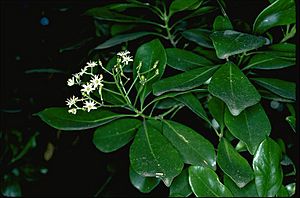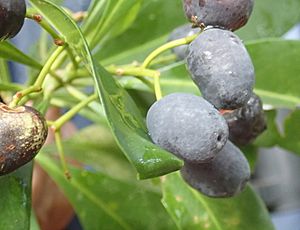Kerosenewood facts for kids
Quick facts for kids Kerosenewood |
|
|---|---|
 |
|
| In Royal Botanic Gardens Victoria | |
 |
|
| Fruit at Cooloola, Queensland | |
| Scientific classification | |
| Genus: |
Halfordia
|
| Species: |
kendack
|
| Synonyms | |
|
|
Halfordia is a group of plants in the Rutaceae family, which also includes citrus fruits! There's only one main type in this group, called Halfordia kendack. People often call it kerosenewood, southern ghittoe, or saffronheart. This plant is a rainforest native found in eastern Australia, New Guinea, and New Caledonia. It can be a small bush or a tall tree. It has oval-shaped leaves, white or yellowish flowers, and purple to bluish-black fruits that look like small plums.
Contents
What Kerosenewood Looks Like
Halfordia kendack can grow as a bush or a tree. It usually reaches a height of 25 to 30 metres (about 82 to 98 feet). The trunk can be up to 75 centimetres (30 inches) wide. Its bark is grey or pale yellowish-brown. It often has rough, wrinkled patches.
Leaves, Flowers, and Fruit
The smaller branches are smooth and green. The leaves grow in pairs opposite each other. They are shaped like an oval or an egg, with the narrower part at the bottom. Each leaf is 50 to 180 millimetres (2 to 7 inches) long. They are 10 to 50 millimetres (0.4 to 2 inches) wide. New leaves have a fresh, aromatic smell, like Eau de Cologne. You can see many small, clear oil dots on the leaves.
The flowers grow in clusters called panicles. These clusters are 30 to 80 millimetres (1 to 3 inches) long. Each flower is about 11 millimetres (0.4 inches) across. The flowers are white, greenish-white, or yellowish. They have short, soft hairs on the back. Kerosenewood flowers from January to May.
The fruit is a purple to bluish-black, round or oval drupe. A drupe is a fruit with a hard pit inside, like a peach or cherry. These fruits are 8 to 12 millimetres (0.3 to 0.5 inches) long. You can find fruit on the tree during most months of the year.
How Kerosenewood Got Its Name
The group of plants called Halfordia was first officially described in 1865. This was done by a scientist named Ferdinand von Mueller. Later, in 1911, another scientist, André Guillaumin, gave the plant its current name, Halfordia kendack.
The name Halfordia honors George Britton Halford. The word "kendack" is a local name for this tree in New Caledonia.
Where Kerosenewood Grows
Kerosenewood grows in monsoon woodlands and rainforests. You can find it from sea level up to 1,260 metres (4,130 feet) high. It lives in New Caledonia, New Guinea, and eastern Australia. In Australia, it grows from the Torres Strait Islands down to Iluka in New South Wales. This includes areas like the Cape York Peninsula in Queensland and the Mcpherson and Tweed Ranges.
Kerosenewood and Wildlife
The hard seed of the kerosenewood fruit is covered in a soft pulp. Many different birds enjoy eating this pulp. These birds include the green catbird, the topknot pigeon, and the wompoo fruit dove. It can be tricky for the seeds to sprout and grow into new plants.
Uses of Kerosenewood
In the past, before materials like fibreglass and carbon fibre were common, the wood from this tree was used to make fishing rods. This wood is very oily and flexible. It is also quite hard, weighing about 1,100 kilograms per cubic metre.
This plant is becoming more popular for growing in gardens. The wood is very easy to burn, even when it's wet. Small pieces of the wood can be used to start a fire. This is why one of its common names is "kerosene wood."
See also
 In Spanish: Halfordia para niños
In Spanish: Halfordia para niños

